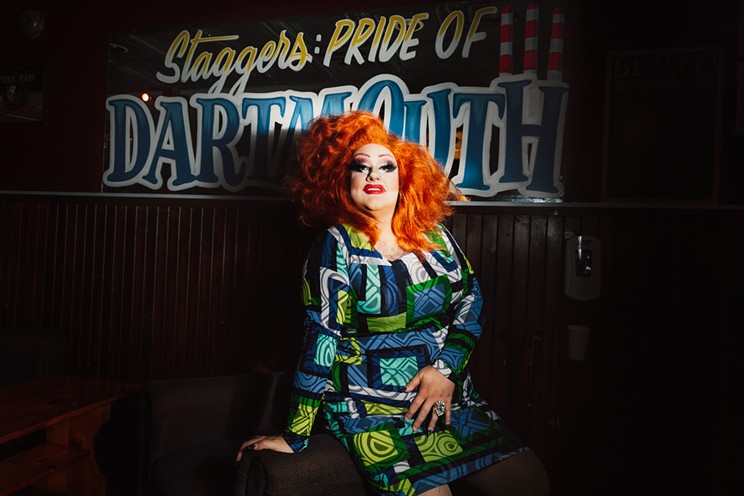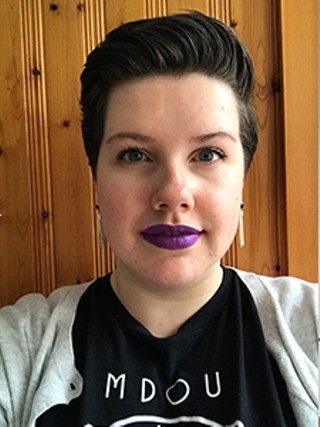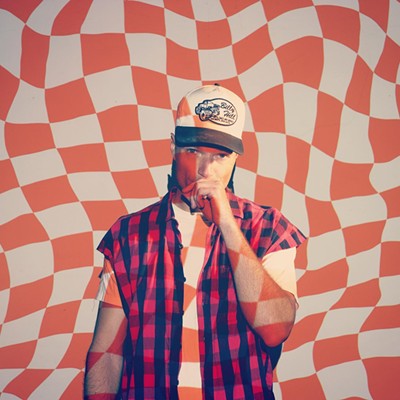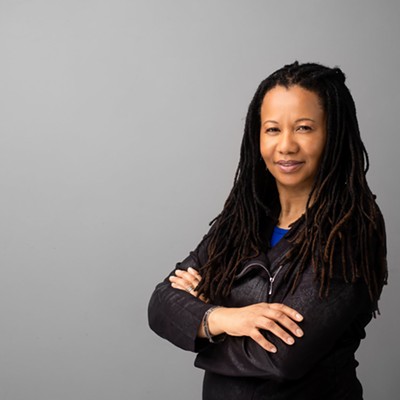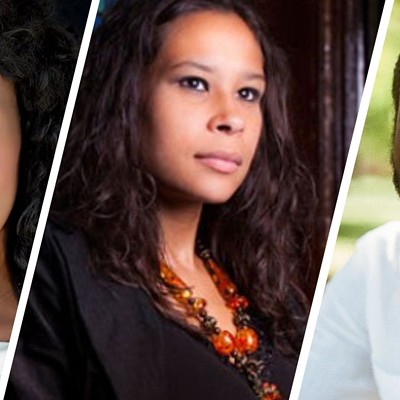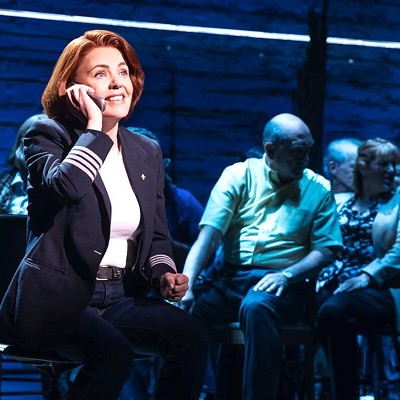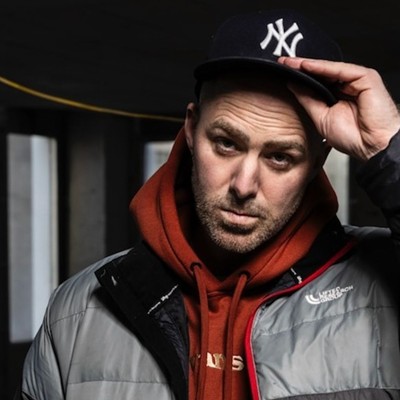When Jason Spurrell—who performs under the drag name Rouge Fatale—took to the stage in a gown for the very first time, it was on a dare. “I had one dress, one wig. One pair of heels. I didn't know I needed an evening gown, I didn’t know anything,” they recall, ice clattering in their glass as they stir it with their straw. If their friends were surprised to see Spurrell follow through and strut the stage at the 2002 Miss Gay Sydney Pageant, the collective shock of what came next must’ve been catatonic: “The thing is, though, is that the person who actually won was 17—and was in it illegally. So they weren't allowed to have the title. And it was given to me because I was second place. And that caused all of this.”
Soon, Spurrell was neck-deep in the world of drag, performing anywhere that would let them (which, in the pre-Ru Paul’s Drag Race era, wasn’t a lot of places) and figuring out their look. The early days were a lot of “hairy legs, fishnets, night gowns, ‘bus driver’ wig (meaning an angled bob hairstyle),” they recall, tapping their purple-navy, coffin-shape nails on the table before them. Soon, their drag mother, Deva Station (an “actual makeup artist,” Spurrell flexes) taught them tricks of the trade and a subtler approach to a finished face.
(Clearly, the lessons took: These days, Spurrell is known for being the epitome of glam, often wearing several sets of false eyelashes at once: “I'm Jason in makeup until I put those lashes on. And as soon as my lashes go on, I go: She's a woman,” they say, batting today’s mascara-slicked lashes for emphasis.)
Twenty years later, almost to the day, Spurrell is tucked in a corner of a downtown Dartmouth pub, laughing about being old and their ever-advancing skincare routine. (Never mind that they look positively poreless and ageless, their makeup-less face offering everything that foundation promises.) Two weeks after this dinner—on Saturday, August 27—they’ll be celebrating two decades of drag with a live show at Stagger's Pub in Dartmouth (attendees can secure tickets—which cost $20—for the 9pm show by emailing [email protected]). “I love performing. I love creating those characters and watching the audience and making them laugh or cry—or showing them that it's not just getting up there and mouthing words. And I think a lot of people don't grasp that,” Spurrell says, their jewel-encrusted manicure catching the light. As a drag performer, “you're an actor, you're creating a story, you're creating that time for those people. It’s my passion.”
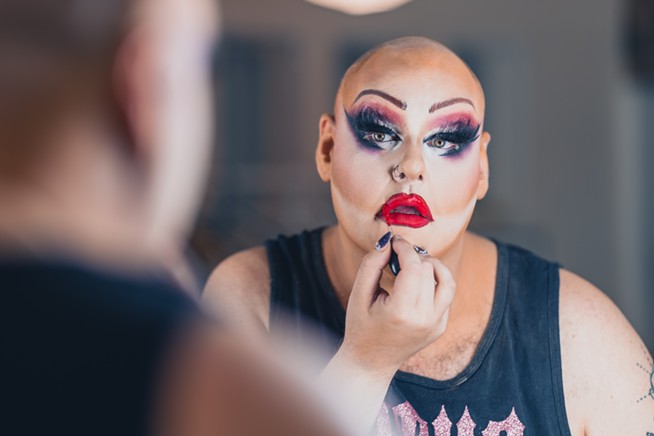
While Spurrell’s drag birth might’ve been during the Sydney Pageant, their first steps towards mastering the genre came two years later: The moment when, despite a show where everything was going sideways, they felt their full potential for the first time. “The power went out. And I was on stage. And I yelled to the audience: ‘Well, you can't see me. But I'm five-six, blonde hair, big, bountiful, bosoms and 120 pounds,’” they say, mimicking the memory’s high falsetto. Then, back to their normal, lower voice: “And the lights came on, and I'm standing there: ‘Or it's me.’ And people died laughing.” They wave down their plus-size frame for impact, a deadpan face only underscoring the moment’s hilarity. Their table mate and best friend, Chris Cochrane (who performs drag under the name Elle Noir) shakes her head, her nails coordinating with Spurrell’s as their laughter harmonizes. “And that's [when] I was like, Oh, fuck, I'm funny. Cool. Let's try this out,” says Spurrell.
It was a different scene back then, Cochrane and Spurrell both attest. “When I started, we were a fringe within our own fringe. Like, we were on the outskirts of the queer community at the time. And it just started coming into play, mainstream-wise, in the last, what? 10 years,” Spurrell says, as Cochrane nods. “RuPaul, at the time, was coming to [the gay bar] Reflections, doing $10 cover shows—and us looking around going, 10 dollars to see a drag queen? Please!” Spurrell adds.
“When I started 20 years ago, you didn't see us at a mainstream event. You didn't see us go and try and do anything. I was told at certain bars not to come in,” Spurrell says. Do they mean bars like the one they’re in tonight, with dim lighting and Journey’s “Don’t Stop Believing” covering the din of denim-clad men at the bar? No: “There was certain [queer] bars we weren’t allowed in—or weren’t appreciated going into.”
Nevertheless, they kept going, performing almost seven nights a week for years—creating the sort of gold-guaranteed live show that’d earn Spurrell a spot in the Best of Halifax Readers’ Choice Awards hall of fame for winning Best Drag Performer for 10 years straight. (Their early makeup by then being long-eschewed for Rouge’s bold eyeshadow, silent-era siren-thin brows and, of course, thick-fringe lashes.) “We went out, show or not,” Spurrell says. “We wanted people to remember us.”
Along the way, Spurrell helped mainstream drag in Halifax, launching a series of high-profile shows at the casino and taking touring shows across the country from Nova Scotia to Yellowknife. It’s gone from “being able to just sort of be that weird little character in the bar scene itself, and just being able to change it: And show people who we are—as opposed to just hiding in the corner,” says Spurrell.
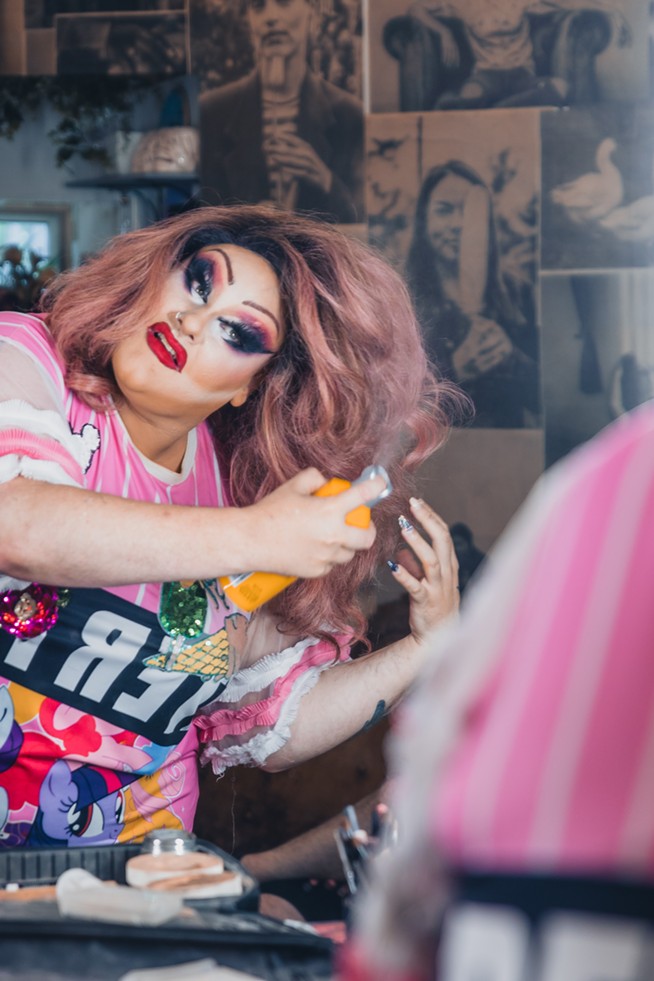
“We did it today: We walk into Walmart, I got these on,” Spurrell begins, referring to their long, manicured nails, as Cochrane nods. “And people look. And people make their comments. And people make comments loudly. I’ve been called f****t in the middle of Walmart. I have been called multiple horrendous things. So it's a difficult thing to be a drag performer, even in mainstream culture. Because you're still not treated like a mainstream society person,” they say.
And while, in some ways, things have remained discouragingly the same during the past 20 years, other aspects of today’s drag culture—and queer life—would probably feel unimaginable to an early-career Spurrell: They and Cochrane track a timeline that went from lack of access to gay spaces for drag performers to commodification of their craft to today’s venue crisis, leaving the cell of their community without a nulceus—or its performers without a guaranteed queer stage to perform on.
“Did you hear the bathhouse closed over on Gottingen street?” Spurrell says to Cochrane. This means that there are now no designated 2SLGBTQ+ spaces in Halifax’s historically queer district. (An entire generation of queer Haligonians built a community and fought for equality in spaces like Menz & Mollyz, which shuttered during the pandemic. These days, on top of all their other labour, artists like Spurrell now need to hustle to find a stage to showcase their work, on top of creating the work itself.)
For a community less resourceful, it’d be easy for the lack of a single dedicated queer stage in HRM be enough for them to pause and crumple. But Spurrell is part of vanguard making sure that doesn’t happen to the local drag scene. Instead, they’ve decided to pioneer their craft in new spaces, building partnerships with businesses to fill the gaps with what they call “ally bars”: Business run by folk who want to help and support the queer community, the next-best-thing to a full-on 2SLGBTQ+ space.
When asked about the next generation of drag performers in the city—the ones who’ll benefit the most from Spurrell’s turning places like Stagger’s Pub into a veritable weekly venue, thanks to their standing Saturday shows at the Portland Street spot, co-produced with drag artists Deva Station and Richard Rockhard—Spurrell’s admiration is palpable: “A lot of the older queens are like: ‘You have to pay your dues’ and everything. But back in our day, we had somewhere to pay our dues: We had shows, we had events to go to, we had queer spaces. They don't,” they begin. “So now they're creating their own. So they are paying their dues. And they’re kicking ass and taking names doing it.” (Later, by email, Spurrell emphasizes that the shows they co-produce are open to all queer artists, at all points in their career. Past events have taken shape as dance parties and drag shows, but the possibilities are endless.)

Spurrell’s schedule these days is an imperfect mirror to the early 2000s: Still stuffed-to-the-margins, yes. But now, it’s filled with more of the managerial and producer work that allows shows to happen and keeps stages both ready and filled. They remember the elders before them: “They made the paths so we could walk in them. We're making it so that they paved it, so they could run it. Each generation needs to bring somebody forward. And it's our turn for this.”
It’s work that dovetails with the other, oft-invisible scene-sustaining that Spurrell has partaken in for decades: Being a “drag mother” (a term for a drag queen who takes younger drag artists under their wing, both onstage and off) to what they estimate to be 15 to 20 queer youth looking for a mentor. “It was more along the lines of: Give them some space, give them a house to come into,” Spurrell says. “Like, my house was the Do Drop Inn. Everybody used to show up. I don't know who's coming. As long as I had coffee in the pot, y’know.” They trace this impulse to include everyone back to childhood: “I'd say, ‘Mom can I bring four people to this Sunday dinner?’ She was like, ‘OK, they might not sit at the table. But there's always a plate.’ So that's what it was. And that's how it always will be.” They shrug, as if this hospitality is just a foregone conclusion.
The impact this care-work has had on others is immeasurable, but that doesn’t mean Cochrane isn’t ready to show just how important it was and remains: “When I met her, I was like Oh my god, a drag queen is talking to me: She was that person when I first met her,” she recalls. “I made her throw up!” interjects Spurrell with a cackle. Continues Cochrane: “And then, she took my wig, tilted it sideways, and said ‘big girls don’t wear parts in the centre,’” she remembers, casting a glance at Spurrell as they smile at the memory.
Of course, it isn’t just the scene or its stages that have changed since Rouge Fatale made her debut in the early 2000s. Spurrell, themselves, has grown, burrowing roots and sprouting blooms. “To keep longevity in this, you have to change yourself,” Cochrane says. “I can stand and perform and make you watch. And that's a performer. That's an entertainer. Anybody can be a performer. Takes a lot to entertain. It's a whole other place in stage,'' Spurrell adds. “You've got your entertainers and you have your performers, you know, and the entertainers are the ones that last: Entertainers are the ones you see holding in the community.”
But what will the next 20 years of Rouge Fatale look like? “There is no way to tell you what it's gonna be like in 20 years—because I didn't expect to be doing this in 20 years,” Spurrell says. “Drag queens don’t last this long.” They take a beat. “ But then after that, if I get to 40 doing drag, I want to be Dame Edna,” (referring to the groundbreaking drag comedian and musical theatre performer.) “I wanna be Canadian Dame Edna: Like that depth—that’s the goal in life.”
Offstage and backstage, their efforts are bound to continue, too: “There's people that have moved the fabric of drag. [When some elders passed,] there was a new art usherment of drag, and I was along with that ride with Rouge. And Rouge then started doing things that other people didn't do: Going to the casino or hosting something here or doing something there or being in theater, doing a touring theatre show. Doing things like that: Bringing drag to where it needed to be. So I think it wouldn't be where it is now,” without Spurrell, says Cochrane, looking straight at her friend. Spurrell looks out the window, but not before a single tear splashes on the table. Soon, the two split the cheque, heading to a rare evening at home, relaxing. Adds Cochrane: “ You know, the microcosm of drag will still be whatever it's going to be. But I think sometimes we have to remember the people that came beforehand, we all had heads up and hands up. But some people in our community like me, and like Jason, do it to leave a lasting message, not just for ourselves—but for who's coming behind us.”

